Six Absurdly Difficult D&D Adventures (That Aren't 'Tomb of Horrors')
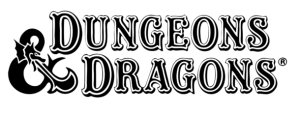
Modern-day pen and paper RPGs stick to the ethic that ‘telling a good story’ is the overriding priority on game night. The Game Master is there to referee the proceedings and ensure everyone plays by the rules, but by and large, the GM’s job is to facilitate an enjoyable experience for all. There are exceptions–Paranoia, for example, gives players six clone lives apiece because the GM is expected to slaughter them for the slightest infraction. But Paranoia’s played for laughs, while Dungeons & Dragons is serious business. Players invest years building 1st-level peons into paragon powerhouses. In light of that investment, capriciously slaying characters is seen as the hallmark of a poor GM, ideally avoided unless the a character does something stupid and/or provocative. There’s only one fitting punishment for the idiot who confuses a sacred idol of Wotan with an outhouse, after all. This wasn’t always the case though. Old school grognards often felt adventures weren’t stories to be shared so much as corpse grinders into which characters should be fed feet first to maximize the agony. I’m excluding Gary Gygax’s original Tomb of Horrors because that one’s just too obvious, but if you want to earn the unrepentant ire of your gaming group, pop one of these bad boys into your campaign. Just don’t be surprised if, in the aftermath, your players suddenly find better things to do on Friday nights.
Note: this is an edited re-publication of an article I originally wrote for Retro Gaming Magazine. It can be read in its original form here.
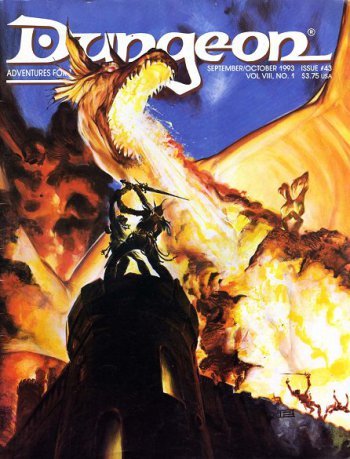
6) “Jacob’s Well” by Randy Maxwell (Dungeon Magazine #43)
Jacob’s Well is a second-edition AD&D adventure I’ve used numerous times to introduce new players to the game. It’s a short one, meant to be completed in a single session, for one GM and one first-level character. This one isn’t for group night, it isn’t for high-level parties, it’s for making the player feel like they’re living Alien or John Carpenter’s The Thing.
Spoiler-Free Summary:
‘Jacob’s Well’ is a small fortified trading post in the middle of the wilderness, named for its half-orc proprietor and the source of its drinking water. While scouting ahead for their party, travelling alone, or otherwise separated from the herd, the player arrives at the Well just ahead of a terrible blizzard. Seeing no other option, they check in to wait out the storm. In the middle of the night, blood-curdling screams ring out, a window shatters, and one of the inn’s clients is found horribly butchered in his upstairs room. With the storm making travel impossible, the occupants are left to face the killer now stalking Jacob’s Well. The longer it takes to root out the problem, the harder that problem becomes to deal with, and the chances of surviving dwindle toward zero.
Maxwell’s adventure requires a considerable amount of prep on the part of the GM, who will need to be extremely familiar with the layout of the small fort, all its inhabitants, and the timeline of events in order to run it smoothly. You’ll want lots of photocopies of different pages so you can organize them yourself, as the way they’re presented in the magazine is inefficient and not conducive to off-the-cuff play. The kicker is, Jacob’s Well is only as hard as the player makes it on himself. Well-organized characters who cooperate with the rest of the inhabitants and come up with solid plans to survive can resolve the encounter in a matter of in-game hours with a minimal body count, assuming they’re both smart and thorough. The NPCs represent a decent, if low-level, cross-section of skills: a young mage, a novice ranger, two barbarians, an Orc chieftain and his two bodyguards, a halfling, a number of guardsmen, some human fur trappers, and Jacob himself are among those who will lend support to any halfway decent plan. Inventive players will convince Jacob to open his stores and lend out weapons and armor to those in need. Those who decide to wait out the nightmare or don’t take an active role in directing the inhabitants’ energies face a threat that grows nastier as the howling blizzard shows no sign of abatement, areas of the fort become uninhabitable, and friendly faces become monster chow.
Best Sprung On:
Anyone in your group known to frequently decry the decisions made by people in horror films. Jacob’s Well is that guy's opportunity to shine. See if they’ve got what it takes to be R.J. MacReady or Ellen Ripley as the star of their own nightmare scenario. It’s the perfect way to set the tone early in a campaign that you want players who are more Batman and less Balboa. And hey, you’re dealing with a first-level character, so you have no reason to hold back. Find inspiration in the words of the philosopher Drago: “If he dies…he dies.”
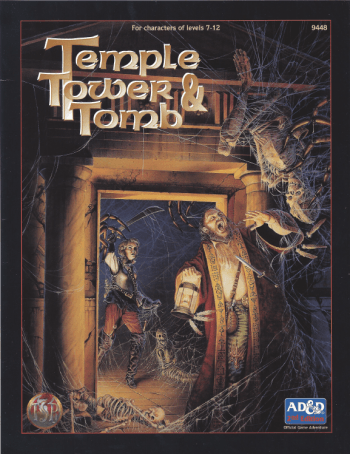
5) “Temple, Tower & Tomb” by Steve Winter & Laura Craig
Temple, Tower & Tomb is three different mini-adventures in one (you might have guessed this from the title), but one 32-page booklet houses them between the same covers, and they’re meant to be tackled in order, one right after the next. This 2nd-edition adventure says it's designed for four to eight characters between 7th and 12th level, but I must assume the editors had partaken of potent pipe weed when they proposed that level range. No other excuse makes sense.
Spoiler-Free Summary:
A kingdom on the brink of war, three powerful artifacts that could turn the tide of battle, and one ruler rich (and desperate) enough to try anything to acquire them. Each artifact is housed in a separate area (hence the temple, tower, and tomb), far enough away that the only means of access is through the magic of the royal viziers. The chance of success is…uh... Well, let’s just say the PCs have to sign waivers agreeing to hold their employer harmless in the event of death, dismemberment, or other catastrophe. When was the last time you had to legally dissolve your right to sue prior to an excursion into unknown territory? ‘Strictly boilerplate’ my ass.
Make no mistake, Temple, Tower & Tomb is not for novices. While each of the three scenarios is short, suitable for 1-2 evenings of play apiece, they are by no means easy. Progress is made through equal measures of skill and luck, and even full parties of 12th-level characters loaded down with magical gear will be hard-pressed to emerge unscathed. Traps abound, with one in the ‘Tomb’ portion of the module virtually guaranteeing a TPK (Total Party Kill) if the players don’t handle it with extreme caution. The monsters are no picnic either, with the nastiest being the ultra-powerful badass boss waiting at the conclusion of the ‘Tower’ segment. Your players will also be ready to kill the asshole who invented ‘Rot Grubs’ before the module’s over, I guarantee it. Beating the monsters and finding the artifact in each area is only the first part of each adventure though. The second half involves getting back home. You still have the little glass teleport sphere securely packed away somewhere, don’t you? You took great care to pad it so it wouldn't accidentally break, even if you fell down a deep pit, right?
You remembered it can only be used outside before you broke it open...right...?
Best Sprung On:
Players who took everything Tomb of Horrors could dish out and laughed. One of the things that put this adventure on the list is the large number of people who simply don’t know about it. While many classic D&D modules are well-known to even casual players either though previous experience or seeing them updated for new editions, Temple, Tower & Tomb came out in 1994 as a generic module adaptable to any campaign setting and was never seen again. So while it’s possible your players may know about the green face with the open mouth from Tomb of Horrors, it’s far less likely they’ll have advanced knowledge of what will happen if they start messing around with those statues.
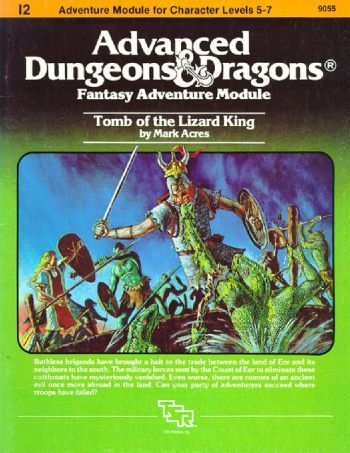
4) “Tomb of the Lizard King” by Mark Acres
First-edition Advanced Dungeons & Dragons modules bearing the “I” designation were meant for an ‘Intermediate’ level range, roughly 4 through 12 or thereabouts. These adventures are meant for characters who've been around the block a time or two, acquired some upgraded and/or magical gear, but aren’t ready to lead the charge into the Nine Hells just yet. The “I” line launched in 1980 with I1: Dwellers of the Forbidden City, and was followed in 1982 by this wheat thresher of a scenario. The former was a campaign tournament module, set in the World of Greyhawk, and was designed differently from most standard adventures, but Tomb of the Lizard King works in virtually any setting. Any setting, that is, where you want to ensure your players’ everlasting desire to thrust your nads into a vise and keep squeezing.
Spoiler-Free Summary:
The Count of Eor has received troubling reports of brigand activity along his territory’s southern border. Merchant caravans are ambushed, travelling pilgrims accosted, and even heavily-guarded traders overrun by the thieves. Survivors are few and far between, but they describe large groups of raiders and some kind of hellish flying creature participating in the attacks. The Count dispatched an entire contingent of soldiers to investigate, and so far none have returned. Whoever is harassing the southern border grows more brazen by the day, and supplies are growing scarce as shopkeepers cannot restock their wares. It falls to the PCs to investigate the thieves, explore the wilderness, and put a stop to the powerful Lizard King before he can grow his ambitions any greater.
I’m convinced Mark Acres thought the “I” designation must have stood for something else when he penned this adventure. Insane, insidious, impossible? I don’t know, but “intermediate” is the last word I would choose to describe this ruthless monstrosity. The module claims it’s written for a party of 7-9 characters of fifth to seventh level, but then goes on to warn the GM about how hazardous the whole thing is and suggests players may want to use the eight pre-generated characters provided instead of risking their own. Warnings like this can sound hyperbolic, but Tomb of the Lizard King is not screwing around. There are plenty of instant-death traps (including a collapsing stairway that dumps characters into a 60′ deep flaming pit, set into an area that must be traversed in order to proceed with the adventure), but the two largest threats even a well-armed and well-prepared party will face, beyond the titular Lizard King, are an all-out assault from a 400-year old Black Dragon with plenty of room to maneuver, and an unavoidable encounter with sixteen Wights (mid-level undead creatures which drain a full experience level every time they touch a living being) that happens during the third and final stage of the adventure. Parties who have lost their Clerics or suffer bad luck here may as well slit their own throats, because this is a potentially game-ending encounter even for a group of high-level PCs with no warning at all that it's coming.
Mark Acres wins. Fatality.
Best Sprung On:
I can’t imagine dropping this on anyone out of the blue, mainly because I would like to keep the few friends I have. As written it contains too many distractions (the journey through the swamp comes to mind, especially if the only guide the PCs might find dies before reaching their destination) to be used as a tournament module, which is honestly where it’s best presented using the pre-gen PCs. Much like Temple, Tower & Tomb, you could throw this at players who shrugged off everything Tomb of Horrors dished out, but Tomb of the Lizard King is far more combat-heavy than ToH even if the Lizard King himself isn’t as dire as a demilich. No group I have ever run this adventure for has survived, whether they were using pre-gens, their own characters, or a mixture of the two. Ultimately this module shares a trait with TT&T, being nowhere near as iconic or well-known as Tomb of Horrors, and thus fewer players will have meta-gaming knowledge to help them avoid or dismantle the nastier encounters. Have your escape route from behind the screen mapped in advance if you plan on running this one.

3) “Die, Vecna, Die!” by Bruce Cordell & Steve Miller
The words “Written by Bruce R. Cordell” should be perceived less as author credit and more as warning label, because nearly everything this guy writes cranks the difficulty knob to 'Devastating'. Die, Vecna, Die! was the final adventure published for Dungeons & Dragons under 2nd Edition rules. Management gave Miller and Cordell a license to go apeshit, so the pair high-fived, put on some heavy metal, and set out to see how far that license would stretch. According to their measurements, it gaped open to the ends of Oerth and beyond. Die, Vecna, Die! is to D&D modules what Aliens vs. Predator was to comic books: the kind of thing every fanboy dreams of writing, but can’t figure out how to without destroying the world. When Wizards of the Coast bought out TSR and transitioned to 3rd Edition, what happened to the 2E property stopped mattering–if that meant an epic-level brawl between a demigod of Greyhawk and a lich-form lesser deity of Ravenloft was only the opening act for this 160-page behemoth, then so be it.
Spoiler-Free Summary:
Writing a spoiler-free summary for Die, Vecna, Die! is like running a sweat-free marathon in the Gobi desert, but here goes nothing. Greyhawk demigod Iuz is on the warpath towards full godhood. In order to do this, he needs to engage a similarly-powered being in combat. His target of choice: his old rival Vecna, currently exiled to Ravenloft. Iuz becoming an even more powerful asshole is something your group of 4-6 PCs of levels ten to thirteen absolutely should not tolerate without a fight. Said fight is a journey that will take them from a besieged temple on Greyhawk to Vecna’s citadel in Ravenloft, and from there to the city of Sigil at the center of the multiverse itself, where the winner of the ultimate Hell in a Cell match earns the power to reshape the universe to his whim.
And your PCs get to stop it.
DVD! was much-maligned upon its release in 2000 for breaking a number of rules the campaign settings for Planescape and Ravenloft established, but as pointed out earlier, this adventure wasn’t meant just to capstone a campaign, it was intended to end an entire product line, much like Transformers: The Movie in 1986. At that point, the rules were there to be broken like limbs in a Tony Jaa film, and whether Vecna or Iuz emerged victorious, everybody everywhere would have the worst day imaginable.
Best Sprung On:
A campaign which has gone on way too long for your liking, when you and your players no longer truly care if they live or die. While a full group of six 13th-level PCs are nothing to sneeze at, Cordell and Miller deliver shock and awe enough to obliterate a party ten times that size. If the phrase “wandering Spheres of Annihilation” doesn’t shiver your timbers, then you don’t understand D&D. There’s enough level-draining, spell-erasing, memory-stripping and proficiency-destroying effects littered throughout to give even the hardiest adventurer pause. If you ever wanted to be the referee for a supernatural no-disqualifications, falls-count-anywhere title belt grudge match, Die, Vecna, Die! is your chance to live out that fantasy several times over. If you want to give your players the desire to discover how many corncobs your large intestine can be reverse-force-fed, Die, Vecna, Die! can help there too.
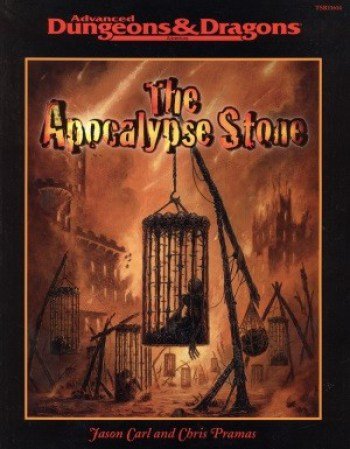
2) “The Apocalypse Stone” by Jason Carl and Chris Pramas
If Die, Vecna, Die! is a campaign-ending shitstorm of all that is awesome in the D&D world, how do you top that? Leave it to Carl and Pramas to design a scenario that looks like the greatest epic-level quest in the world but leaves the players on the hook for consigning everyone to oblivion. Designed to be campaign-agnostic unlike Die, Vecna, Die!, The Apocalypse Stone is basically the ultimate unwinnable adventure. There’s about a 1% chance your players will do everything needed to keep the Multiverse intact, with any deviation resulting in a second Big Bang. In this case, feel free to judge the module by its cover because that's exactly what you're getting.
Spoiler-Free Summary:
A sage recounts some long-forgotten lore about fabulous treasure and a divine trial of some sort which, if overcome, ensures those who complete it go down in history as the greatest heroes of all time. This sends the group to seek out Castle Pescheour, a monster-infested stronghold ruled by its gibbering and insane king, which teleports from remote location to remote location across the world, never remaining in the same place for more than a week or two, wherein is located the treasure sought by the players. Upon return, the players present the treasure to the avatar of a divine being and cement their status as true heroes of the ages. Excellent!
Then the world begins falling apart. Bogus...
Now the heroes have to not only figure out what’s causing the problems, they have to live with the fact something they did might lie at the root of the matter. Another divine avatar appears before them, this time not to offer wealth or favor, but to give them one chance to fix what is broken. The only question is, can they actually undo the damage, or is the world doomed to expire no matter what?
The Apocalypse Stone holds nothing back from either the GM or the PCs. Players who survive the initial foray to retrieve the treasure of Castle Pescheour live only to face the nightmare of a world going horribly wrong, the machinations of a pissed off demon, a potential fight with the deadliest non-deity creature in the Monster Manual, and the slaughter of everyone they hold dear. What’s worse, the module tells the GM to flat-out lie to the players and suggests running a number of adventures after the expedition to Pescheour to keep them from immediately figuring out what’s causing the calamity. The Apocalypse Stone is not nice, not kind, and absolutely not recommended for people lacking strong stomachs. Make sure you get seconds on the pork buns though–they really are out of this world!
Best Sprung Upon:
Players who believe their characters are so perfect they can do no wrong. Following the standard RPG script on this one is a recipe for disaster, literally, and both players and characters will have to do an awful lot of outside-the-box thinking and playing against trope to have a ghost of a chance at fixing stuff. The good news is, whether they succeed or fail, the campaign’s shot to hell anyway. When you’re ready to start telling new stories, when you need an excuse to switch to a new rule set, when you want to expose the players for the heartless, desensitized little munchkin power-gamers they truly are, it’s time to break out The Apocalypse Stone. It eliminates even the toughest campaign stains in just one cycle, while giving your players a reason to eliminate you just as enthusiastically.
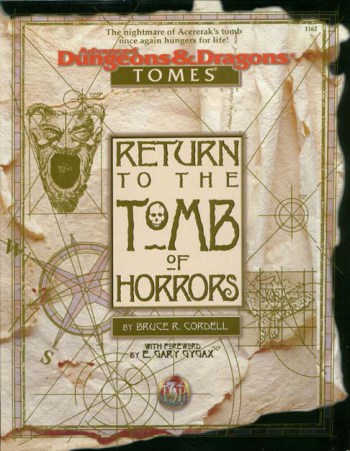
1) “Return to the Tomb of Horrors” by Bruce R. Cordell
Oh, man. I know what you’re thinking: “The title says no Tomb of Horrors, you knob goblin. Why are you lying to me, on the internet of all places?!” Well, like Obi-Wan Kenobi, what I told you was true…from a certain point of view.
Gary Gygax’s Tomb of Horrors itself does not appear in any of the entries on this list. On the other hand, when I read Bruce “My Name Heralds The Apocalypse” Cordell’s authorized sequel/re-imagining, I realized leaving it off the list would be doing a disservice to apprentice-asshole GMs everywhere. Apocalypse Stone and Die, Vecna, Die! might be world- and character-ending super-modules, Jacob’s Well is a great way to terrorize a single player, but RttToH exists solely to do both to high-level parties. No one but the most phenomenally prepared group ever assembled is finishing this adventure without multiple TPK’s. Cordell wrote this boxed set for the D&D equivalent of Navy SEALs and Green Berets–weekend warriors need not apply. I have never run a scarier, more difficult adventure for my players than this one.
Spoiler-Free Summary:
Everyone knows about the Tomb of Horrors, and the stories of the demilich Acererak who resides within. Anyone with common sense knows to stay the hell away from it, especially after a powerful group of adventurers known as The Band of the Hand entered the Tomb and returned with nothing but tales of death, woe, and shattered sanity. Unfortunately, avoiding the Tomb is no longer an option. A school of Necromancers, devoted to the worship of Acererak and guided in their studies to elevate him to godhood, has sprung up around the nightmarish dungeon. Bolstered by their affinity, the demilich has put the most evil plan imaginable into motion. If Acererak succeeds in his diabolical scheme, it will mean utter ruin to the Prime Material Plane. If he is to be stopped, it will take a group of high-level adventurers willing to gamble sanity and soul to do so. Taking on the demilich means a return trip to the Tomb, but that’s only the beginning. The ending is much, much worse.
Return to the Tomb of Horrors is an absolute nightmare, no two ways about it. It’s meant to be a full-fledged campaign, designed to take months or possibly even years of game time, as the PCs gather intel, follow leads, investigate new mysteries, and travel the length and breadth of Greyhawk in search of not just the Tomb but a way to combat the vile mastermind buried within. They’ll fight giants, infiltrate an academy of Necromancers, face down legions of undead, and bear witness to some of the most unspeakable atrocities ever put to print in an official D&D product. PCs reaching the final encounter will likely find themselves in a position where defeating Acererak means consigning thousands of innocent souls to annihilation at the expense of slowing down the demilich’s play for power for a few centuries. Actually ending the threat posed by Acererak permanently will be beyond the reach of all but the most thorough PC groups, and should it happen, characters and players alike should be heralded as a bunch of god-blessed legends worthy of ascension to some immortal pantheon.
But to do that, they have to escape the Fortress of Conclusion first, and getting out ain't as easy as getting in, bub.
Best Sprung Upon:
There is absolutely no way to spring something like this boxed set on smart players. Any PC worth her intelligence stat knows to give the Tomb of Horrors the same wide berth as you'd give to flesh-eating bacteria. You could start the campaign with players who are in the dark, but as soon as the name Acererak pops up, everyone with any common sense is going to say, “Nah, we’re good. Someone else can take over from here.” Return is written for a group of 4-8 characters of thirteenth-to-sixteenth levels, but even the most perfectly-balanced team will be hard-pressed to navigate very far in this one without taking some fearsome casualties (the opening encounter with 10 Wights being a perfect example of tone-setting written to cost unwary characters valuable experience levels). You will only ever run this adventure for players with teeth set and loins girded to take on the worst the world has to offer. Their PCs should be the sort who would get bounced from the Marine Corps for unnecessary roughness. Just reading the adventure made me feel dirty. GMing this monstrosity is not for the faint-of-heart, and can only end in one of two ways: you’ll have players ready to practice their own necromantic rituals on your corpse for mincing their PCs into hearty salsa, or the campaign will go down in history as one of the greatest heroic escapades of role-playing ever experienced by your group. So…are you game?
Some one please help me!!
I'm just beginner in this association, i've join to this association 5 days ago. My topic is about YuGioh Duel links. it's themed about card trade gaming.
May i know? Can you tell me why every time i post some thing it's can not to reach $4. I hope some day my post can be a trending.
More to know about Yugioh Duel Links?
Follow @akun2017
Thank you for you all steemit friends for your time
I wish I could tell you, but I don't have any idea. I just write what I write...if it gets popular, it's because other people liked it enough to upvote it, I suppose. :)
I was never an advanced player (probably only played 25-30 sessions ever), but I always loved hearing people's off-the-wall stories about D&D, Pathfinder, etc. This article is snappy and very well-written. I can imagine the hair-pulling and crushed beer cans. Great article, @modernzorker!
Thanks, @horrorguyian! I've been fortunate enough to grow up along with RPGs, in a sense, watching their evolution from a decidedly DM-vs-Player format into White Wolf's storytelling system format then to the 50/50 split of them with D&D 3.5. Considering how well this one did, I'd be a fool to avoid writing more stuff about my role playing career thusfar. :)
I would definitely read more
Me too!
( ••)
( ••)>⌐■-■
(⌐■_■)
You're making me feel old, as I had a library of several hundred first edition D&D books back in the day. But it's great fun to read these summaries and reviews.
Never did play "Tomb of the Lizard King," though. I would add "The Lost Caverns of Tsojcanth" to your list. A pretty basic plot but it was good for several brutal marathon sessions, and I can't remember if we actually finished it.
Pretty much every module in the S-series was brutality incarnate (although given S1 was Tomb of Horrors, I can see why this may have happened). I wrote a companion/sequel piece to this one earlier this year, and I'll re-post it here after this one's had it's chance to shine, though Tsojcanth didn't make the list. If I write a third, I certainly welcome suggestions, so if anyone else has any they'd like to see write-ups on, speak up! My collection is mostly comprised of 1E and 2E content, with a smattering of 3E and a handful of Judge's Guild stuff. I don't collect 4E or 5E though. Had to draw the line somewhere. :)
Also: we aren't old, we're vintage or collectible now. ;)
Don't suppose you ever ran any pathfinder (3.75)?
No, although I have some of the supplements and rule books they produced. Second-hand market for Pathfinder stuff is absurdly expensive, and waaaaay out of my price range for a lot of things. I love that they were able to continue the 3.5 license, as I think that rule-set was incredibly player-friendly, but finding the time to get a group together for even one session, much less a weekly one, seems to get harder the older one gets. :(
Gotta check out the "We be goblins!" Set. It's a free series they add to every year
That's right - we just keep getting more and more valuable!
I can't remember too many other adventures in particular, except for "Horror on the Hill," which was one of the first Basic Level ones. Oh, and "The Lost Island of Castanamir" was pretty mind-blowing.
I loved the art in the early D&D. It left so much more to the imagination.
Horror on the Hill is the only module in the B-series I'm still missing from my collection. They collated a bunch of the B-series modules into a super-module called In Search of Adventure, but the Horror on the Hill segment was edited to exclude the first 19 encounter areas. The fight on the bridges over the lava was always epic. :)
I don't have Castanamir either, now that I'm looking at my checklist...drat!
I just checked eBay for it. Man, looks like I should have held on to those old modules.
It's funny, I remember the toy store in the mall marking them all down to $1 each, marching in and getting everything I could. Then years later when I was moving I took the whole collection to the gaming group at the community college and sold them off for $3 each. I felt like I'd done pretty well.
You had me at John Carpenter's The Thing meets Alien, since those are two of my favorite films. This seems like a good list, but I don't think I own more than a few things for AD&D 2nd edition.
Do you blog RPG reviews of newer (but old school) products? Because I'm a small time self-publisher who has some stuff I'd like reviewed.
Thanks, @venger.satanis! Jacob's Well is a criminally good module that doesn't get anywhere near enough love, so if I can turn a few more people on to it, I'm happy to do so.
Sadly, my blog reviews will be limited to old school D&D for the most part, since that's the only RPG system I'm truly familiar with. If I had a group, I'd accept review offers for newer material, but it doesn't seem fair to offer up a review on a product I can't fully put through its paces. :)
Keep checking around on Steemit though, especially in the 'gaming' area. You're likely to find someone else willing to review product. You might also check out "Geeking In Indiana":
http://geekinginindiana.com/
He has his own podcast, keeps a blog, and is always looking for new stuff to talk and/or write about! :)
Great post ! Today i just lost my job...i worked really hard as a waiter for like 10 years in a restaurant...worked night after night shifts but still they decide they don't need my services anymore and that they don't have money to pay me so they just kick me out . It was really hard for me to find this job because i don't have much education....i did't go to college...
The real problem is that i have a debt of 759 $ to my apartment rent and if i don't pay till the end of the month they gonna kick me out from my own home. I don't have friends and my family won't lend me any money...
My only hope now to raise this money is steemit...i like it alot here and the community is very nice...
Please if anybody would like to help me , a upvote would be awesome and would help me tremendously to raise the money i need .
Thank you very much for your help and i hope you have a great day .
I'm just glad I found you, even though you scared me with this post, but will come back to it anyway. New GM here and are now just doing lots of research.